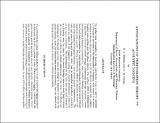Browsing Earth Resources Laboratory by Author "Ellefsen, K. J."
Now showing items 1-10 of 10
-
Acoustic Logging Guided Waves In Transversely Isotropic Formations
Ellefsen, K. J.; Cheng, C. H.; Schmitt, D. P. (Massachusetts Institute of Technology. Earth Resources Laboratory, 1988)We have studied the velocity dispersion of guided waves in transversely isotropic formations. Theoretical velocity dispersion curves were calculated with elastic constants based on laboratory and field measurements and ... -
Application Of Rayleigh's Principle To Guided Waves In A Borehole
Ellefsen, K. J.; Cheng, C. H. (Massachusetts Institute of Technology. Earth Resources Laboratory, 1988)The Lagrangian for guided waves in a completely general borehole model is presented. Rayleigh's principle is used to derive the first order perturbations in wavenumber and frequency due to slight perturbations in the ... -
Applications Of Perturbation Theory To Acoustic Logging
Ellefsen, K. J.; Cheng, C. H. (Massachusetts Institute of Technology. Earth Resources Laboratory, 1989)For guided wave propagation in boreholes, perturbation theory is used to calculate (1) the partial derivative of the wavenumber or frequency with respect to an elastic modulus or density, (2) group velocity, and (3) the ... -
Effects Of Anisotropy Upon The Normal Modes
Ellefsen, K. J.; Cheng, C. H.; Toksoz, M. N. (Massachusetts Institute of Technology. Earth Resources Laboratory, 1990)The effects of anisotropy upon elastic wave propagation along a fluid-filled cylindrical borehole are determined. The wave equation is solved in the frequency-wavenumber domain with a variational method, and the solution ... -
Estimating A Shear Modulus Of A Transversely Isotropic Formation
Ellefsen, K. J.; Cheng, C. H.; Toksoz, M. N. (Massachusetts Institute of Technology. Earth Resources Laboratory, 1990)A method to estimate c[subscript 66], which is a shear modulus of a transversely isotropic formation (with its symmetry axis parallel to the borehole), is developed and tested. The inversion for c[subscript 66] is based ... -
Estimating Phase Velocity and Attenuation of Guided Waves in Acoustic Logging Data
Ellefsen, K. J.; Cheng, C. H.; Duckworth, G. L. (Massachusetts Institute of Technology. Earth Resources Laboratory, 1987)Phase velocity and attenuation of guided waves have been estimated from multireceiver, full waveform, acoustic logging data using the extended Prony's method. Since a formation affects velocity and attenuation, estimating ... -
Estimating Phase Velocity And Attenuation Of Guided Waves In Acoustic Logging Data
Ellefsen, K. J.; Cheng, C. H. (Massachusetts Institute of Technology. Earth Resources Laboratory, 1988)Phase velocity and attenuation of guided waves have been estimated from acoustic logging data recorded by a receiving array. The method uses data from multiple sources and successive depths yielding more accurate estimates ... -
Estimating The Elastic Moduli Of Transversely Isotropic Formations
Ellefsen, K. J.; Cheng, C. H. (Massachusetts Institute of Technology. Earth Resources Laboratory, 1989)Using acoustic logging data, we develop a method of estimating the horizontal shear modulus C[subscript 66]) of a transversely isotropic formation with its axis of symmetry parallel to that of the borehole. The data for ... -
Guided Waves In Slight, Azimuthally Anisotropic Formations
Ellefsen, K. J.; Cheng, C. H. (Massachusetts Institute of Technology. Earth Resources Laboratory, 1989)A method of calculating dispersion curves for guided waves in slight, azimuthally anisotropic formations is developed with perturbation theory. The fluid is assumed to be inviscid, the formation perfectly elastic and ... -
Homomorphic Processing Of Acoustic Logging Data
Ellefsen, K. J.; Burns, D. R.; Cheng, C. H. (Massachusetts Institute of Technology. Earth Resources Laboratory, 1991)A new processing method, which we developed for the guided waves generated during acoustic logging, accurately estimates the wavenumber when only a few seismograms are available or when the seismograms are irregularly ...









